
Hi Archinect,
We're in full Piper tonight for a historic event, the Walter Gropius Lecture, delivered by our Chair of Architecture, Preston Scott Cohen. [I'll add a link to the video when it's posted; this blog post is just the low-budget teaser for a must-watch blockbuster film.]


[Photo op with a succession: Gerald McCue, Harry Cobb, Rafael Moneo, Mack Scogin, Jorge Silvetti, Toshiko Mori, Preston Scott Cohen]
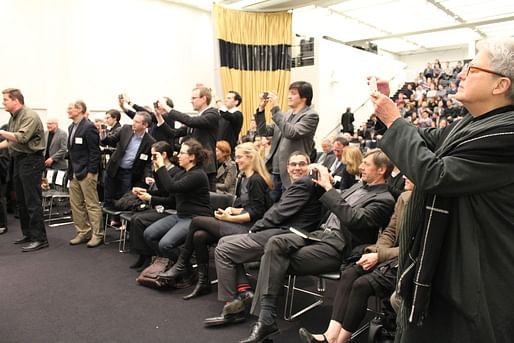 [Black on black on black]
[Black on black on black]
6:41: Dean Mohsen calls things to order. "As you've already witnessed, this is an emotional occasion, a family occasion, a moment of intimacy and friendship and...it's hard to make this introduction."
"We just had a photo of the chairs of architecture. I'm of course delighted to be making this introduction, but also sad. Preston Scott Cohen is the Gerald McCue Professor of Architecture, and we're honored that Gerry is also here. Scott was the first chair that I appointed here, and I've known him since...almost his student days. He managed to bring Peter Eisenman, Daniel Libeskind, [etc.], and...managed to create quite a scene here.
He's collaborated with a lot of people, many of whom are here, but one who is not--the late Robin Evans--whose work had [a lot of resonances with] Scott's own work. Scott's always been interested in things that are not so straightforward, not so direct, and not so rational. So for him, in Contested Symmetries, he has been interested in the notions of contestation, anomalies, and imbalances, held in a certain moment. This is apparent in the Tel Aviv Museum, in which the central space--Lightfall--is an inversion, held together against the balance of the galleries.
Scott is one of a few people who have gone through the education here, investigated something [deep] to the discipline and gone on to practice in a manner that is true to those investigations while also being faculty here. His work in teaching has been central, especially in the core [of the M.Arch.I]; I don't know of anywhere else in the country where work of this quality is produced at the end of the first semester, and that is to your credit, Scott.
There is a book, to be out soon with Erika Naginski, The Return of Nature. I'm hoping that now that Scott is not going to be chair for a little while, he will continue to lead us through his ideas, teaching, his arguments--and God knows, he does know how to argue. ...Would you join me in welcoming Preston Scott Cohen.
6:51: Thank you. I will now try to turn over to the talk, which is hard for me, after that introduction, which was really moving to me. Thank you.
Digital instruments are effectively capable of displacing authorship: authorial will, composition, and artistry. Computation is attractive to us because it reaches beyond...to other spheres, lending architecture greater relevance. But more attractive still is how it [aligns architecture with] important discourses of contemporary art.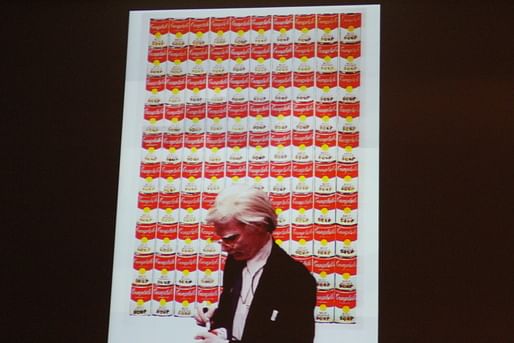
20th century art: questioning authorship. Warhol cleverly made an analogy to Fordist production. Art becomes a theory of art; cultivating the author instead of forms and techniques, it participates in something larger, and more overtly political.
Even more important, which we don't like to admit, is that association with artistic projects of the avant-garde, such as pop...this relationship establishes architecture among the other disciplines [legitimizing it in institutions]. But this [artistry] has too often limited itself to the façade cladding, not the structural, or the social impacts of architecture.
The distinction between façade and structure has to do with vertical succession--the skyscraper of the 19th century, as you all know--the elevator, and steel... Only its composition can be controlled by single authors. The building as the city defines it must be a different thing. Spaces piled vertically almost always produce a single building. While horizontal series are one of the foundational forms of urbanization, this vertical piling is [the realm of architecture.]
...Thus for all the spatial and social ambitions of modern architecture, the schisms of succession end up relegating architecture's social role to spaces of shallow relief. [Sad.] Tafuri...Venturi, Scott Brown...Koolhaas' bigness, is similar to Tafuri. The envelope--what's left of architecture. And today's parametric envelopes, managing quantitative effects (like heat gain) while producing qualitative effects. Architecture for all intents and purposes might as well disappear.
The interest tonight is to understand what the new reality means for architecture. One of the themes I propose, which will seem too extreme, I know, is that vertical succession now qualifies all buildings, large and small alike.
For example, what about the trope of expressing the inside on the outside? It didn't always take the best form. ...The argument here is that vertical succession is one of the primary protagonists of the architectural medium of our time.
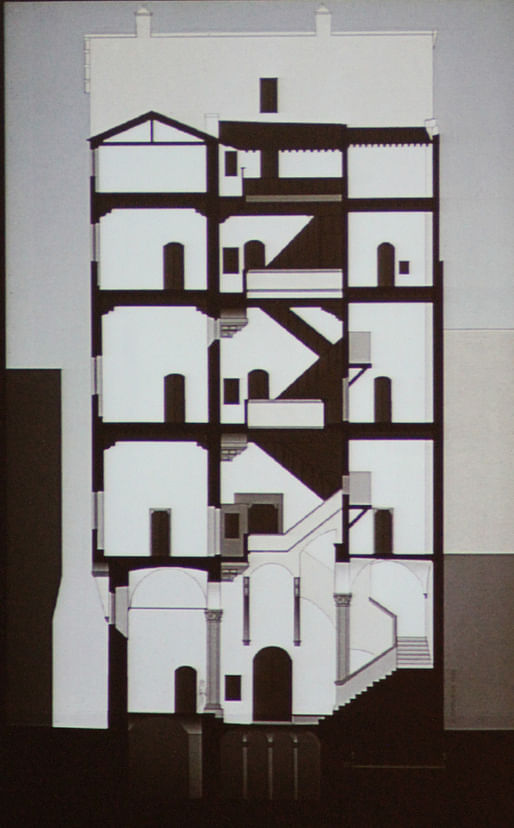
What are its qualities? The one-after-the-otherness. ...But I digress; it was not always this way. Before the elevator, you had the piano nobile. ...Once the elevator arrived, ceremonial stairs became different or could..disappear completely. A single front door on the front facade proliferated; the elevator became the new front door. Plans such as the Beaux Arts articulated horizontal succession. Space in a modern building are...free to represent non-sequentiality, or horizontal succession.

Given how the project of the Farnese began... the moment the architect emerges... when Michelangelo took over from Sangallo, [he dealt with both horizontal and vertical succession.] What interests me is how he handled the question of the horizontal. It is indicative of a new architectural response to the city. The building could expand or contract a bay or two without consequence, without a sense of the whole. Michaelangelo reasserts an idea of the whole with [the ornament marking the center of the building at the entrance] and the combinations of series of pilasters...pairing, again and again, to generate this possible expansion and contraction.


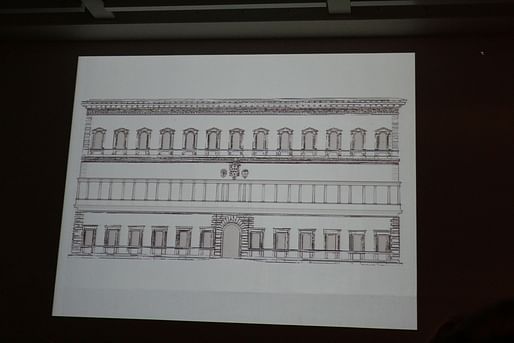
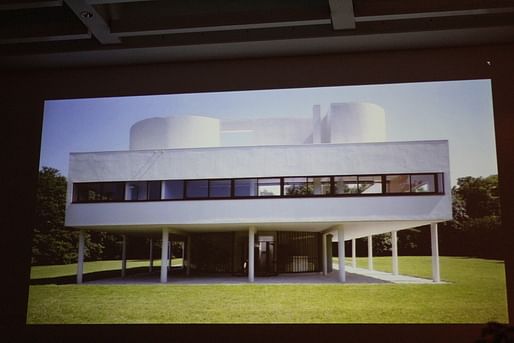
If we can say that Michelangelo put seriality and succession in conflict and resolved it in the vertical axis, then it is obviously with symmetry and seriality that he did so horizontally. His most subtle contraction is the central void; the unexpected depth to the facade that he introduces there. The absence of a window which makes the space between the central columns seem larger, even though it's in fact smaller...[the modern extension of this thinking, Scott implies, is in the Villa Savoye.]
Here [Corb] we have an architect who gave up the ground floor--gave it over to the city, which he made into a garden. ...He singularizes the top as penthouse, turning the old hierarchy on its head. In contrast, the one story building does not suffer this contradiction: it is coextensive with the city. The one story building is urban form itself. It is inseparable from it.

A building is a building; it is one. They aggregate or can have [overlapping] programs, but it is one. It is bound and delimited. The many is formlessness, unauthored, the sprawl, the field of one stories. Or it can be authored, but only in fragments.

The argument I'd like to make is that architecture needs to author the disintegration of architecture. ...It must content with the way the discrete building comes to terms with unauthored horizontal succession. It must deal with the problem of the ground or the entrance level. How does architecture, which is a medium, meet the city, which is not a medium? Does architecture treat the ground floor as the city, or as medium?
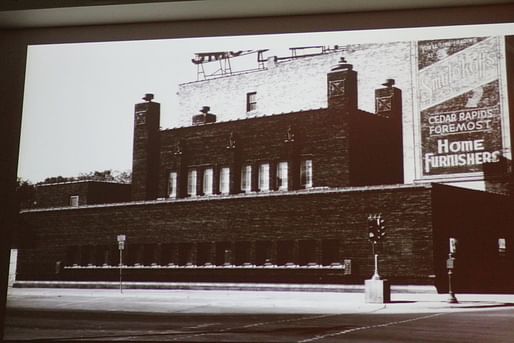
Here we have a small building, acting as if it were a house, or a small skyscraper--he drew it in a field.


Leaving aside all these one stories. I offer three possibilities to deal with the problem: 1. to negate, 2. to exaggerate, 3. to mime vertical succession.

1. To negate. Louis Sullivan. It is well known that he called for floor to floor stacking to be vitiated by the base, the top, the verticality [spanning between]. Less well known is the cellular sense of being in the building. [The walls are thick.] The sense in the interior is less about being in a chamber somewhere in the air, and more about being placed along the vertical stalk.

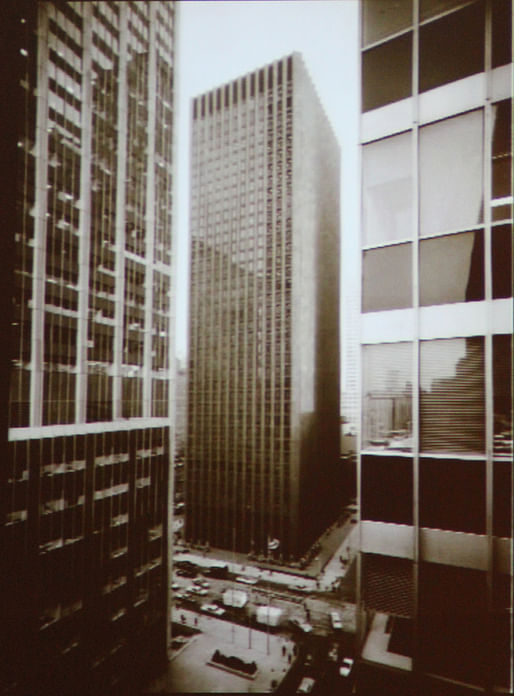
Mies gives way to the stacking of horizontality. Though [he unites the form], the floors threatened to [take over].

For Saarinen, the building is all middle. You slip in through the columns. The tower is set down a few steps, to suggest that the building arises from below, as if it could just keep going.
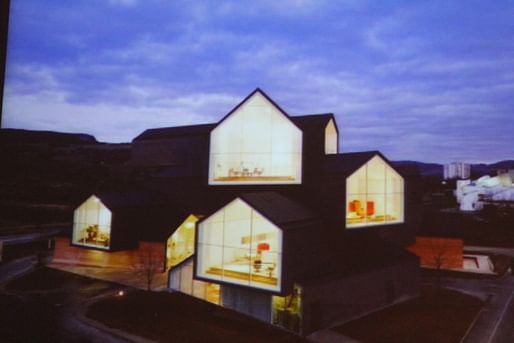
As a footnote to this giant order of vertically successive architecture. I wanted to show you this idea--the giant order stack--that has played out. This tends to spectacularize, and I'll say trivialize, the notion of piling.

Now, 2. to exaggerate. FL Wright's Guggenheim in NYC. Wright manages to resynthesize multiple paradigms of the museum. First, it is caught between being multiple rooms, and one room--one gallery. It is caught between being a display, and a place where the spectators are on display, like a diorama.

It is also caught between being an enfilade on one side, and a picture gallery on the other.


MAD's slabs in Mississauga, Ontario, rotate. They turn the notion of stacking into the whole building. No two units are alike and it produces diversity in a way--relentless differentiation, very uncommon in highrise buildings. All of this is baked (parametrically) into the structure's layout.

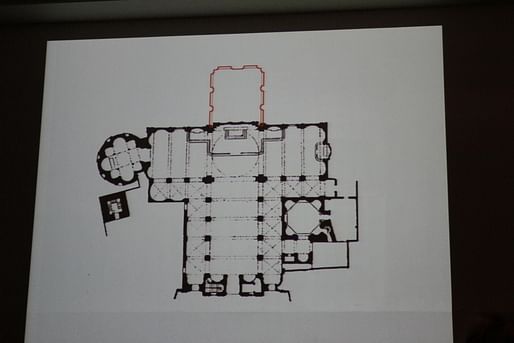
In order to understand 3. miming vertical succession. Bramante's Santa Maria presso San Satiro. This is the building represented by the trompe l'oeuil. As you move through the experience you have the experience of a space compressed or decompressed. The trompe l'oeuil mimics not only the space that isn't there, but the process of spatial compression itself. It mimics something pressing in from the other side. Obviously, the street is not actually pushing the street in. But pretending that it is active--as we do here sometimes--this is one way to understand what the trompe l'oeuil is doing. One would have thought there was space--deep space--in which the clergy would be seated. But it isn't there. It's a fundamental betrayal.
This relates to another analogy, which is important to set up the end of this game.
As we move in the building, we oscillate between seeing something frontally and seeing something obliquely. What we have in San Satiro is an instance in which architecture imitates painting in the way it imitates architecture. This brings us to the question of the medium, but we have to turn to a different medium to establish an analogy. In the 20th century we can through an analogy with film, which effectively succeeds painterly perspective.
One of the most obvious parallels is that when the plans of a multi-level building are presented in a book, one after the each other on successive pages, the flipping of the pages can create a primitive form of a film. The flip-book. Nice idea, but the analogy is only convincing for one type of building: the sky scraper. But...this whole analogy doesn't hold up, because in the succession almost nothing happens. Things may come and go but the plans are essentially the same. The variations would rarely reach even the minimal transformation necessary for a narrative in film.

But what about surveillance footage? Both are non-narrative, and the site remains fixed except for incidental changes. Warhol's Sleep. He replaced the filmic depiction of events with real-time, a premonition of surveillance footage. It is non-narrative duration, without a definitive beginning or end. The flipbook creates...[a non-narrative film], but Warhol helped us to understand. The flicker (changes from floor to floor) is because Warhol wanted to make sure we knew the film was running.
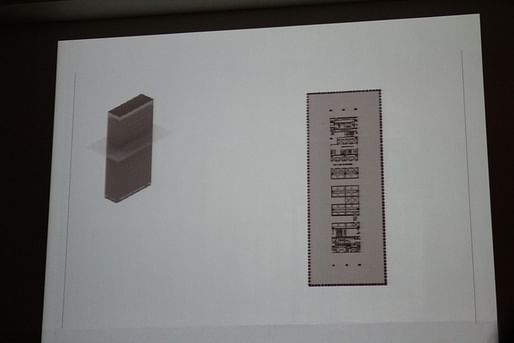

While Saarinen allowed verticality and horizontality to flicker, Cobb made no concession to the stacking within; it is a purely exteriorized object, emphasized by its skewed, notched plan. This makes the plan shape look like a die-cut profile, as if the extrusion has clipped rather than capped ends. It's as if one of the (mullions?) on the Seagram Building was blown up to become the entire building.


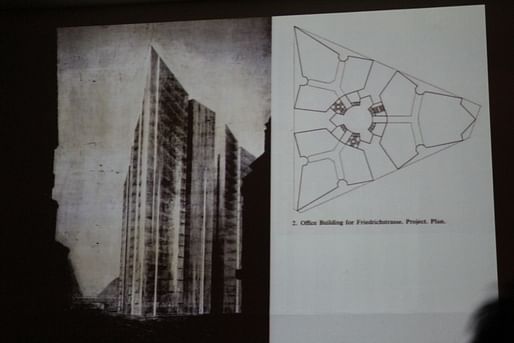
At this point it is important to recognize that extrusion, when horizontal, is not successive architecture...it is not required to be organized according to [horizontality] and the structure does not have to be informed by it either.
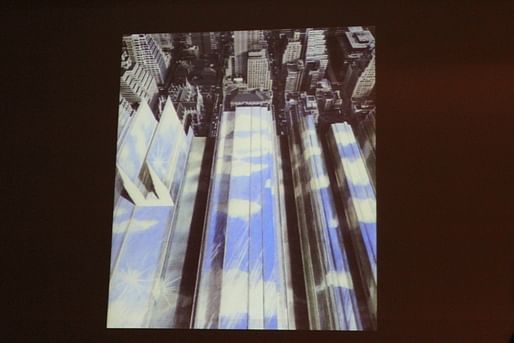
There is another example that I want to bring to your attention. ...
..Look at this again. If there could be a plan of the Guggenheim [playing a film of a horizontal section sweeping up the building]. it would be the fulfillment of the flip book, like conventional film. Defining continuous narrative development.
This idea, of being cut: Renaissance plans were conceived of as cut, rather than drawn...the plan is not generative. Corbusier's idea was very radical, that it would become generative. We have a generative plan in a few special buildings. Or sectioning in the anatomical model. Those are the plans of the Guggenheim.
Here we have Chris Marker's la Jetée. He makes...a series of stills, variously paced, with one motion picture section. It takes succession to its extreme.

The closest architectural project to la Jetée is Koolhaas' Karlsruhe. Like an architectural montage--the plans are like time travel. We have Corbusian plans, and even a hypostyle, the Beaux Arts, a tholos (circular). Koolhaas moves architecture closer to avant-garde film.
There are others that are more explicit and allegorical. Koolhaas' 'The House in Bordeaux,' ...necessitated in this case by the fact that the client was disabled.
Or this one: the dream house. It's a dream only for them--for Venturi, Scott Brown--because it's a decorated shed. Even for the house, where the inside and outside are most capable of being unified, and are unified, by their surbanity--why does it have to behave like a building, like architecture?
For Koolhaas...it is the city. His [favorite] building, the Downtown Athletic Club, is unlike any other. Koolhaas pretends it's a typical skyscraper, but this is a slight of hand. He keeps for himself a tactic that allows himself to assert an author by manipulating the medium, through vertical succession. The wild adjacencies are anything but unauthored. He proves to be at pains to create uniqueness, even though he argues against it.

As an epilogue, I'd like to present a case, astonishingly close to home, which I believe epitomizes many of these conditions. The Round House is in Somerville...a few hundred feet to where we were all locked down. It's a wooden Sullivan, a house on its own, a house behaving like a small building. It is entirely centralized, so much that it insists, the way Harry Cobb would have, that there is no entrance at all. The problem is that with a form like this, the door creates a hierarchy against the building's claim of no hierarchy. It fixes the building to its surroundings, betraying the idea that the building is non-oriented.
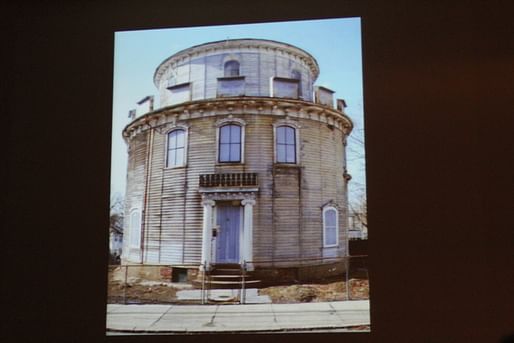

Let's start that this is first and foremost a cylinder. The door intrudes--it comes in from below. So much that when the windows fall in their tracks, we even witness a profile which seems to be the tracks that the windows slide in. But the alternating pattern represents more than stacking--it also represents rotation and the vertical access. More importantly, it obfuscates the door. 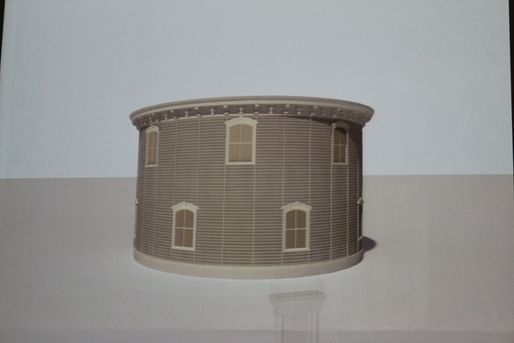
This is the pattern that would allow the door to be absorbed, somehow, into the pattern. This pattern of windows is insistently non-hierarchical, and if we assume the rotation implicit in this pattern, it implies a stacking.

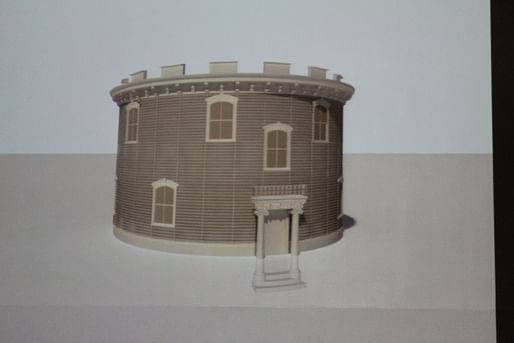
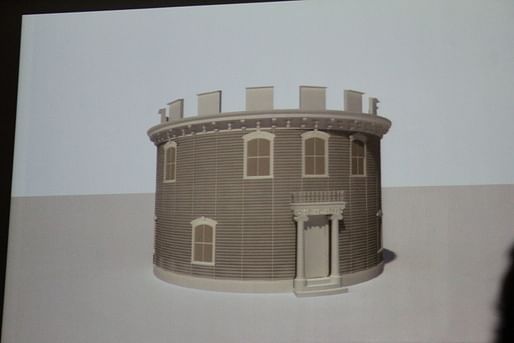
Now we see the window that is displaced upwards by the door--it becomes an anomaly.
Also in the plan: it is adjusted so that you enter as if in the middle, just as in any stacked building [when you effectively enter via the elevators].
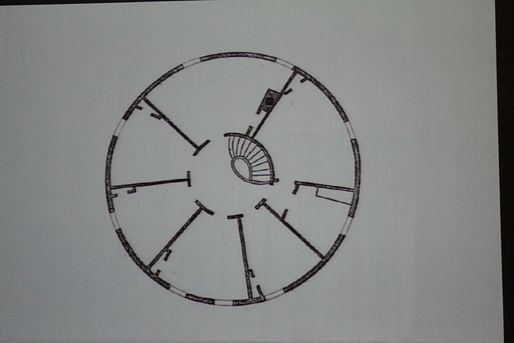

Now we look at the idea of moving it along. the building would be raised so that you drift in under it--except for the fact that it wouldn't be a disc. The building would have to take a new form to be true to two principles at once. This building is the vernacular, the building on the ground; but also, the pilotis building that is raised; and finally, it is the surface building that combines the two without having to choose between them.
Altogether, tonight, I intended to offer a series of observations. And perhaps I should not draw these to a conclusion. We could ask if these phenomena--the phenomenon of succession--will continue to exist, or whether it will turn out to be a historical episode. I would say that we can't know in the final analysis, what will succeed succession. Whether there will be one day an architecture...without floors...I would say that there will always be interest in mining familiar things to [imagine things that don't exist]. The perpetuation of the search for solutions...will never be fully realized. After all, it is only the unfulfilled promise that holds the promise that will go on and on. Thank you very much. [standing ovation]
8:02: Mohsen: One thing that I would say; I was wonderfully surprised by some of the argument, because it seemed that for the first time I see you argue strongly for the performative in the sense of Chris Marker or the idea of the scene, setting, the cut between one scene and the other. It's about the performative dimension of the interior which is not to do with the form, but the performance, or the juxtaposition of experiences. On the one hand, you're arguing for form, but on the other, it seemed to me, you're arging for the performative--the duration, of watching the five hours of sleep, of my body to the performance and my participation of it. That becomes very different from the articulation of form in its own internality.
PSC: I like very much your perception of this, and that it brings us so close. ...For a long time I found the most compelling aspects of architecture to be invested in these characteristics. The staircase, which is a motivating feature in so many projects, and in pedagogy. [Demanding the architect to think both ways--performatively and geometrically]. So we have some problems to solve--I don't think I talked enough about a very interior, deep space--but it's the most important to architectural education.
Question from Matthew Waxman: It seems that you read successiveness from the exterior, whether in Hancock or Sullivan. In either case, the presence of the ground--how the building meets the ground--is important. I'm wondering how you'd speculate on the ground imposing order from the exterior? Could the ground, or the order or successiveness of the city, take a part in shaping the successiveness of the building?
PSC: Hm, hm, Matt. I'm imagining the Hancock tower, wrapping, taking the whole ground with it...[laughter]...We tried that in one of my studios...[laughter]...We took Beaux-Arts buildings and twisted them, took up the ground...and it didn't work. [laughter]...
I would hope, as in the Villa Savoye, that the building re-imposes the interior. Skyscrapers can't do this, but all the other buildings that have caught the virus of succession can deal with it in many different ways.
Mohsen: What about the relation to the city? The ground floor is different from the others by virtue of its relation to the city.
PSC: It doesn't do very much, ultimately...Though there is the question of the penthouse, which Corbusier knew, that that is how the hierarchy would ultimately be. But...hm...I'm going to have to give this more thought. We could have some coarser grain change...but this isn't really a talk about tall buildings, as funny as that might seem. The tall building is just the instigator for the problems that all buildings have.
MM: Harry, do you have any...?
Harry Cobb: You just used a word that wasn't in your talk. Sequential. Successive is very different from sequential. I assume you used "successive" to emphasize the non-hierarchical nature. When you say "sequence," I assume there's a hierarchy and I can only assume the theme of your talk has deeply embedded in it that the abolition of hierarchy is a crucial evolution in architecture.
PSC: Absolutely. When I showed the Beaux-Arts plan, I wanted to be clear that the sequentiality is still there; that was a very different world.
Harry Cobb: Do you equate the abolition of hierarchy with the abolition of architecture?
PSC: No, when we fight again succession--recompose it, restructure it--when it's still there but work with it some other way, that's authorship, and architecture. Without that it is just relentless succession. You are a successive architect, obviously; like what Warhol did.
Mohsen: Thank you so very much. [Standing ovation.]

[And then, my classmates Fareez Giga and Hal Wuertz take the podium to present a roast of the chair, which is traditional for outgoing chairs, as well as selections of some more heartfelt reflections from students about Scott's impact on our education and relationship with architecture.]
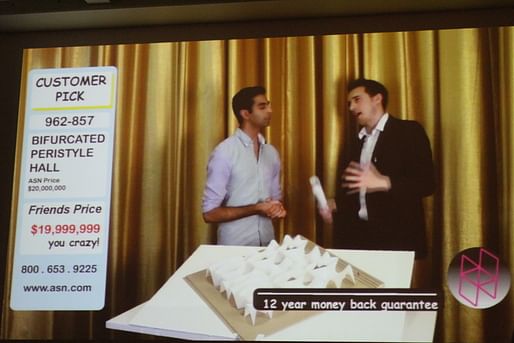
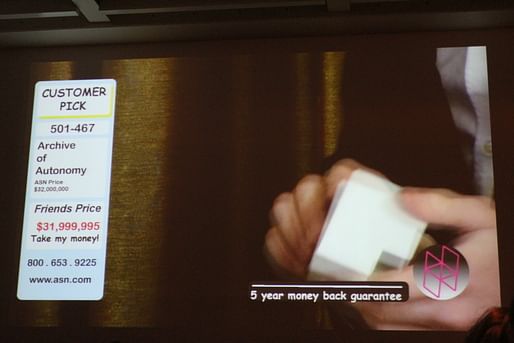
[The movie speculated on what Scott will do with himself after he steps down as chair: sell architectural fragments/models on a TV shopping channel.]
PSC: Thank you! It's too much for one person to bear, it's so over the top. And you all are going on so much farther than I'll be able to go--and I know that's how so many of the faculty here feel, that it's about where you all are going. Thank you.
Bravo, Scott. It was a lecture worthy of your tenure as chair.
Thank you for reading!
Lian
This blog was most active from 2009-2013. Writing about my experiences and life at Harvard GSD started out as a way for me to process my experiences as an M.Arch.I student, and evolved into a record of the intellectual and cultural life of the Cambridge architecture (and to a lesser extent, design/technology) community, through live-blogs. These days, I work as a data storyteller (and blogger at Littldata.com) in San Francisco, and still post here once in a while.



8 Comments
Love the shout out to the round house. Another local building (in JP) that might be of interest:
http://en.wikipedia.org/wiki/House_at_17_Cranston_Streetm
more info here:
http://radioboston.wbur.org/2012/04/05/jp-house
I loved that too! An unexpected and delightful end to the lecture. I pass by that house often.
This lecture is everything I don't miss about architecture school. Here's a sampling:
"The argument I'd like to make is that architecture needs to author the disintegration of architecture. ..." - This makes no sense, but did anyone bother questioning this?
"How does architecture, which is a medium, meet the city, which is not a medium? Does architecture treat the ground floor as the city, or as medium?" - Kind of depends on a little bit more than a made up paradigm, no questions please.
"Digital instruments are effectively capable of displacing authorship: authorial will, composition, and artistry." - Again, if you say so...
"Computation is attractive to us because it reaches beyond...to other spheres, lending architecture greater relevance." To whom does 'computation' lend archtiecture greater relevance?
"Architecture for all intents and purposes might as well disappear" ???
Don't get me wrong, I've seen this game played for years and am equally aware of the rules, the main one being, don't question any premis. Like kids at Coachella when asked about what they think of non-existant bands with made up names and they play along not wanting to be seen as a country bumpkin. (http://www.huffingtonpost.com/2013/04/23/kimmel-coachella-lie-witness-news_n_3137809.html?utm_hp_ref=mostpopular)
What continually fascinates me is that the same logic that questions our government's illegal wars and corporate malfeasance seems to go out the window when playing this game that most of our great institutions pass of as archtiectural education. A mind is a terrible thing to waste.
@thayer - my understanding is that the first point is essentially that buildings are objects in the landscape (even if you are playing the whole transparency and public/private games by shifting location of the envelope, bringing outside program inside, etc...- i.e. 'disintegration') and must come to terms with its surroundings - essentially a jab at the "soft systems" people who do a lot of self-serving parametric objects devoid of context. he then says that computation is seductive, but the way it is used (in academia) tends to strips away authorship and in turn, responsibility (I put the data in and this is what came out! boom!).
then he goes on to discuss the difficulty of making tall buildings that aren't shitty.
As far as lectures go, this wasn't that opaque.
It would be nice if architects could speak in a way that dosen't require insider knowledge of all the games being played, but thanks for the translation, it makes a little more sense now.
woah! he's stepping down? is someone slated to fill the position?
Just to add that it's not quite fair to Scott to get picky about exact wordings as reported here--the live blog is a paraphrase, necessarily with omissions and mistakes.
For example, one aspect of the lecture that I'm not sure I was able to capture was Scott's point about authorship. Implicit to his argument was a suggestion that we should get rid of authorship. Not to just let go of authorship thoughtlessly by riding the wild pony [my words] of digital tools, but to do so in a particular way. I would describe this in terms of trying to invest the building design itself with authorship--maybe a Kahn-type argument about "what does the building want," but more fraught and complicated than that. A building design has a number of things it wants to be, but it has to negotiate contexts and circumstances that push it in different directions; and its own desires also push the building in opposing ways. Rather than let one desire steamroll over the others, or try to pretend these competing interests don't exist, the way I understand the argument is that we should find ways to allow designs to express these tensions, all the way from its massing/parti/programming to its structural resolution, materiality, ornament, and detailing.
@uhhhhh: yes, it seems that someone is slated to fill the position.
Excellent liveblog, as always, and thank you Lian for the further clarification in the comments.
Also the roast looks hilarious. This would have been a fun event to attend.
Block this user
Are you sure you want to block this user and hide all related comments throughout the site?
Archinect
This is your first comment on Archinect. Your comment will be visible once approved.